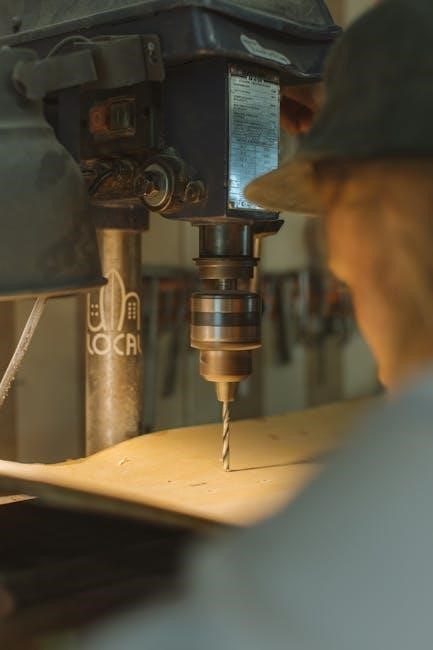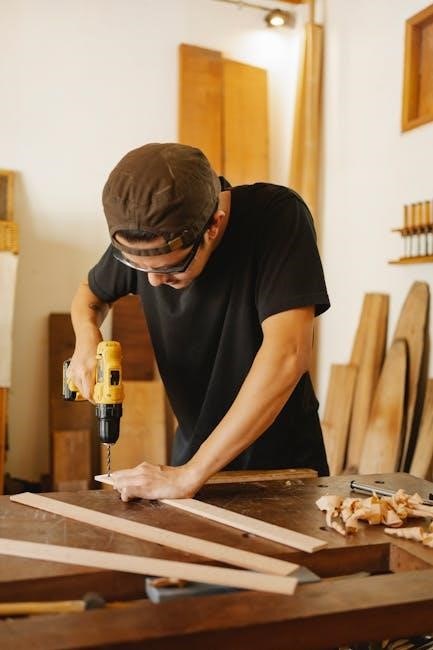
The Craftsman radial arm saw is a versatile power tool designed for precise cutting and versatility in woodworking projects․ Its robust design and adjustable features make it ideal for various tasks, from ripping lumber to making intricate cuts․ Understanding its operation through a detailed manual ensures safety and mastery of its capabilities, making it an essential resource for both beginners and experienced woodworkers․
1․1 Overview of the Tool and Its Versatility
The Craftsman radial arm saw is a legendary tool known for its versatility and precision in woodworking․ It can perform tasks typically done by miter saws, table saws, and even surface grinders, making it a standout in workshops․ Capable of crosscuts, rip cuts, and angled cuts, it offers unmatched flexibility․ With proper setup and calibration, as detailed in its manual, it delivers cuts with remarkable accuracy, making it indispensable for craftsmen seeking efficiency and quality in their work․
1․2 Historical Context and Evolution
The Craftsman radial arm saw emerged in the mid-20th century, revolutionizing woodworking with its innovative design․ It combined the functions of a miter saw, table saw, and surface grinder, making it a groundbreaking tool․ Over time, it evolved to include improved safety features and precision adjustments, solidifying its place in workshops․ Its enduring popularity is a testament to its versatility and the detailed guidance provided in its manual, which has helped generations of woodworkers master its capabilities․

Safety Precautions and Best Practices
Always wear safety glasses and a dust mask when operating the saw․ Keep loose clothing tied back and avoid jewelry that could catch․ Ensure proper blade guards are in place and maintain a clean workspace to prevent accidents․ Follow the manual’s guidelines for safe operation and regular maintenance to optimize performance and ensure user safety․
2․1 Essential Safety Guidelines
Always wear safety glasses and a dust mask to protect against debris․ Keep loose clothing and jewelry tied back to avoid entanglement․ Ensure the blade guard is properly installed and functional․ Maintain a clean, dry workspace to prevent slipping․ Never reach over the blade while cutting, and keep children and pets away․ Familiarize yourself with the manual’s safety instructions before operation to minimize risks and ensure safe usage of the radial arm saw․
2․2 Personal Protective Equipment
Wear safety glasses to protect your eyes from flying debris․ Use a dust mask to avoid inhaling sawdust․ Hearing protection, such as earplugs or headsets, is essential due to the loud motor noise․ Gloves provide grip and prevent splinters․ Avoid loose clothing or jewelry that could get caught in the blade․ Proper PPE ensures a safer and more controlled operating environment when using the radial arm saw․

Understanding the Features and Components
The Craftsman radial arm saw features an adjustable fence, a sliding arm for precise cuts, and a sturdy work surface․ Its design allows for versatility in woodworking tasks, ensuring accurate and efficient cutting operations․ Understanding these components is crucial for optimal performance and safety․
3․1 Key Parts of the Radial Arm Saw
The radial arm saw consists of a motor, a sliding arm, a rotating blade, and an adjustable fence․ The motor powers the blade, while the sliding arm allows for precise movements․ The fence ensures straight cuts, and the work surface is designed for stability․ These components work together to enable accurate and efficient cutting in various woodworking applications, ensuring versatility and reliability in the workshop․
3․2 Adjusting the Fence and Work Surface
Adjusting the fence and work surface is crucial for accurate cuts․ Align the fence parallel to the blade and secure it firmly․ Ensure the work surface is level and stable, using shims or spacers if necessary․ Proper alignment prevents binding and ensures precise cuts․ Regularly check and adjust these components to maintain optimal performance and accuracy in your woodworking projects․
Maintenance and Adjustments
Regular maintenance ensures optimal performance․ Clean the saw, check blade alignment, and lubricate moving parts․ Adjustments should be made carefully to maintain accuracy and safety during operations․
4․1 Truing the Wheel and Blade Alignment
Truing the wheel and aligning the blade are critical for accurate cuts․ Use a diamond tool to true the wheel, ensuring it’s perfectly round․ Align the blade with the fence, adjusting the tilt and arbor to maintain parallelism․ Proper alignment prevents binding and ensures smooth operation, while truing the wheel enhances cutting consistency and reduces wear on the saw․
4․2 Lubrication and Regular Maintenance
Regular lubrication of moving parts ensures smooth operation and prevents wear․ Clean the saw frequently to remove dust and debris․ Check and replace worn components like belts and bearings․ Proper maintenance extends the tool’s life and maintains accuracy․ Always refer to the manual for specific lubrication recommendations and maintenance schedules to keep your Craftsman radial arm saw in optimal working condition․

Operating the Craftsman Radial Arm Saw
Mastering the operation involves understanding safety protocols, proper alignment, and cutting techniques․ The saw excels at crosscuts, rip cuts, and angled cuts with precise adjustments for accuracy․ Regular practice and consulting the manual ensure optimal performance and versatility in woodworking projects․
5․1 Basic Cutting Techniques
Start by ensuring the saw is properly calibrated and aligned․ For crosscuts, position the fence accurately and feed the material smoothly․ Rip cuts require aligning the blade with the material edge․ Maintain consistent pressure and use the provided guides for straight cuts․ Always keep hands away from the blade and use push sticks for smaller pieces․ Practice on scrap wood to refine your technique and achieve precise results consistently․
5․2 Advanced Operations and Tips
For advanced cutting, master techniques like angled cuts and dado joints by adjusting the blade and fence precisely․ Use jigs and fixtures for complex shapes and repeat cuts․ Maintain blade sharpness for clean results․ Apply steady, controlled pressure to prevent binding․ Utilize the saw’s capacity for deep cuts by adjusting the arbor․ Explore beveling and mitering for decorative edges․ Always refer to the manual for specific setups and safety tips to enhance precision and efficiency in your projects․
Troubleshooting Common Issues

Troubleshooting the Craftsman radial arm saw involves diagnosing motor issues, addressing alignment problems, and ensuring proper blade maintenance․ Always refer to the manual for specific solutions and safety guidelines to resolve common operational challenges effectively․
6․1 Diagnosing Motor Problems
Diagnosing motor issues in the Craftsman radial arm saw involves checking for unusual noises, overheating, or reduced power․ Ensure the motor is properly lubricated and free from debris․ If problems persist, consult the manual for specific troubleshooting steps or consider professional repair to avoid further damage and ensure optimal performance․
6․2 Resolving Accuracy and Alignment Issues
To address accuracy and alignment problems, ensure the fence is parallel to the blade and the table is level․ Check the blade alignment with the fence and verify the workpiece is securely held․ Regularly truing the wheel and adjusting the saw’s components can prevent misalignment․ Refer to the manual for detailed calibration steps to achieve precise cuts and maintain the saw’s performance over time․

Accessories and Upgrades
Essential accessories include a diamond truing tool, table extensions, and precision blades․ Upgrades like improved fences or digital alignment systems can enhance functionality and cutting accuracy․
7․1 Essential Accessories for Enhanced Functionality
Essential accessories like diamond truing tools ensure blade accuracy, while table extensions provide extra workspace․ Precision blades and adjustable fences enhance cutting precision and versatility․ These additions optimize performance and expand the saw’s capabilities for various woodworking tasks, ensuring smooth and accurate cuts every time․
7․2 Upgrading and Customizing Your Saw
Upgrading your Craftsman radial arm saw with precision blades, enhanced fences, and custom jigs can significantly improve accuracy and versatility․ Consider adding a dust collection system or motor upgrades for better performance․ Customizing the work surface or installing anti-vibration mounts ensures smoother operation․ These modifications enhance functionality and tailor the saw to your specific woodworking needs, achieving professional-grade results․
Comparing with Other Tools
The Craftsman radial arm saw stands out for its precision and versatility, often compared to miter saws and table saws․ It excels in specific tasks, making it a valuable addition to any workshop, as detailed in the manual․
8․1 Radial Arm Saw vs․ Miter Saw
The radial arm saw and miter saw cater to different needs․ While the radial arm saw excels in versatility, handling tasks like ripping and crosscutting with ease, the miter saw specializes in precise angled cuts․ The manual highlights these distinctions, helping users choose the right tool for their project requirements, ensuring efficiency and accuracy in woodworking operations․
8․2 When to Choose a Radial Arm Saw
Opt for a radial arm saw when versatility and adaptability are key․ Ideal for handling large workpieces, it excels in ripping, crosscutting, and angled cuts․ The manual suggests using it for tasks requiring precision and flexibility, making it a valuable asset in workshops where diverse cutting needs arise frequently․ Its robust design ensures reliability for both small and large-scale projects․
Installation and Setup
Proper installation and setup are crucial for optimal performance․ Follow the manual’s calibration guide to ensure accuracy and safety․ Optimize your workspace for efficiency․
9․1 Initial Setup and Calibration
Initial setup involves assembling and aligning the radial arm saw according to the manual․ Ensure the saw is level and securely fastened to a sturdy workbench․ Calibrate the fence and blade alignment for accuracy․ Refer to the manual for specific instructions on truing the wheel and adjusting the saw’s components for optimal performance․

Proper calibration ensures precise cuts and prevents vibrations․ Follow the manual’s guidance to achieve a stable and accurate setup, which is essential for safe and effective operation․
9․2 Optimizing Your Workspace
Optimizing your workspace involves organizing tools and materials for efficient workflow․ Ensure the area around the saw is clear, well-lit, and free from obstructions․ Position frequently used accessories within easy reach to minimize distractions․ Maintain proper ergonomics by adjusting the work surface height and ensuring good visibility․ A well-organized workspace enhances safety, accuracy, and overall productivity when using the radial arm saw․
Resources and Further Learning
Explore official Craftsman manuals, online forums, and video guides for in-depth knowledge and troubleshooting․ These resources help master the radial arm saw’s capabilities and address common issues effectively․
10․1 Recommended Manuals and Guides
Consult the official Craftsman Radial Arm Saw Manual for detailed instructions and safety guidelines․ Additional resources include the Know-How Manual and the Craftsman Contractor Series Guide, offering step-by-step tutorials․ Online forums and video series, such as the Radial Arm Saw Know-How series, provide practical insights․ For troubleshooting, refer to the Radial Arm Saw Adjustment Guide, available on platforms like eBay, ensuring optimal performance and safety․
10․2 Online Communities and Forums
Engage with woodworking forums like Woodworking Talk and Reddit’s r/woodworking for tips and discussions on the Craftsman radial arm saw․ These platforms offer user experiences, troubleshooting advice, and project ideas․ YouTube channels and specialized groups share tutorials and hacks, fostering a community of enthusiasts․ Participate in Q&A sessions and gain insights from experienced users to enhance your skills and resolve challenges effectively․
Mastering the Craftsman radial arm saw requires consistent practice and adherence to safety guidelines․ With proper care and technique, it becomes an indispensable tool for precise woodworking projects․
11․1 Final Tips for Mastering the Radial Arm Saw
Regularly clean and lubricate moving parts for smooth operation․ Always use the correct blade for your material․ Keep the saw well-maintained and aligned for accuracy․ Practice on scrap wood to refine techniques․ Read the manual thoroughly and follow safety guidelines․ Organize your workspace to ensure efficiency and precision․ With patience and practice, you’ll unlock the full potential of your Craftsman radial arm saw․